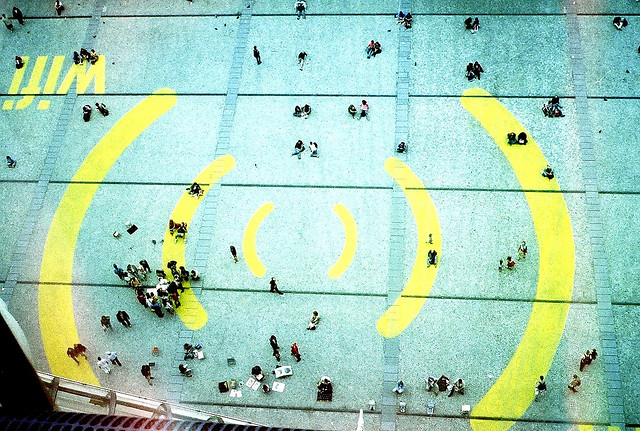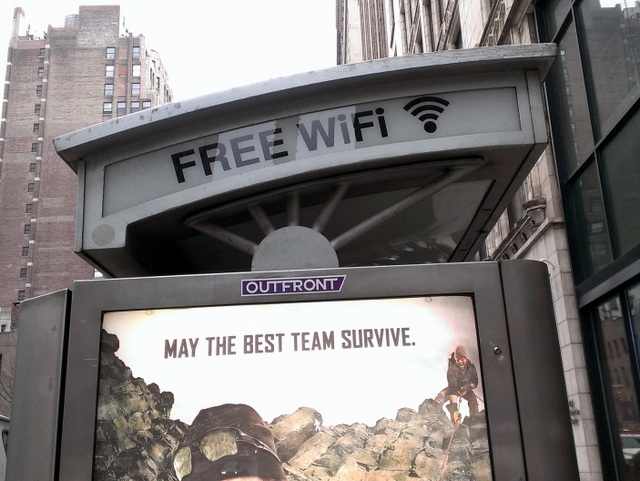
By most accounts, New York is usually ahead of the game in innovation. So how is it that when it comes to public WiFi, the city has been lagging behind? Two recently unveiled plans are changing how New Yorkers connect on our commute and on the streets by providing free public WiFi. It’s time to get connected!The Internet Pioneers Right now, Europe leads the world when it comes to wireless innovation and connectivity. According to a study done by iPass, the world’s largest commercial network, Europe contains half of the world’s public WiFi hotspots. France snags first place among European countries, boasting over 260 hotspots in Paris alone. Across the Channel, free and public WiFi courtesy of The Cloud has taken over the United Kingdom, with thousands of hotspots completely wiring the centers of many smaller cities.They’re getting creative on the other side of the Atlantic too. Portuguese-American startup Veniam, which shares founders with Zipcar, has created the first network to provide public Internet access from hotspots on moving vehicles. Since September 2014, they’ve connected 608 vehicles from garbage trucks to city buses, providing 60,000 users with WiFi access, and yes, they’re counting. Now, the Silicon Valley based company is expanding into the US market with the receipt of $4.9 million in Series A funding. With New York’s own Union Square Ventures as one of their backers, perhaps the Big Apple is next in Veniam’s project to wire the world’s one billion vehicles, one taxi at a time.Where Does NYC Stand?While the United States slides in second to France in amount of hotspots, the comparison is hardly valid when comparing the size of the two countries. Sheer numbers do not necessarily equal good coverage, as we can see here in New York, where connectivity is minimal.Although New York does have public WiFi hotspots in popular locations including parks (for example, Madison Square Park) and transit hubs (such as Grand Central Terminal), if you don’t live or work near these central areas, chances are you remain unconnected. Below ground, the MTA lists seventy-six WiFi connected stations, but that’s a drop in the ocean compared to the total 468 stations. And if you’ve ever tried to connect, you may have been disappointed. Often the signal only works on a small part of the platform, if it works at all.
Right now, Europe leads the world when it comes to wireless innovation and connectivity. According to a study done by iPass, the world’s largest commercial network, Europe contains half of the world’s public WiFi hotspots. France snags first place among European countries, boasting over 260 hotspots in Paris alone. Across the Channel, free and public WiFi courtesy of The Cloud has taken over the United Kingdom, with thousands of hotspots completely wiring the centers of many smaller cities.They’re getting creative on the other side of the Atlantic too. Portuguese-American startup Veniam, which shares founders with Zipcar, has created the first network to provide public Internet access from hotspots on moving vehicles. Since September 2014, they’ve connected 608 vehicles from garbage trucks to city buses, providing 60,000 users with WiFi access, and yes, they’re counting. Now, the Silicon Valley based company is expanding into the US market with the receipt of $4.9 million in Series A funding. With New York’s own Union Square Ventures as one of their backers, perhaps the Big Apple is next in Veniam’s project to wire the world’s one billion vehicles, one taxi at a time.Where Does NYC Stand?While the United States slides in second to France in amount of hotspots, the comparison is hardly valid when comparing the size of the two countries. Sheer numbers do not necessarily equal good coverage, as we can see here in New York, where connectivity is minimal.Although New York does have public WiFi hotspots in popular locations including parks (for example, Madison Square Park) and transit hubs (such as Grand Central Terminal), if you don’t live or work near these central areas, chances are you remain unconnected. Below ground, the MTA lists seventy-six WiFi connected stations, but that’s a drop in the ocean compared to the total 468 stations. And if you’ve ever tried to connect, you may have been disappointed. Often the signal only works on a small part of the platform, if it works at all.
What’s New: On the Go Subway Kiosks
The MTA is starting to change that with the launch of the On the Go kiosks in subway stations, which provide service status updates and trip planning options to 1.2 million people daily. The first wave of 140 six-foot-tall stainless steel pillars now stand at the ready in thirty stations. The kiosks will also act as WiFi hotspots, so mobile users can stay connected while waiting for their trains.Shopping also recently got easier with On the Go. During the weeks preceding Christmas Day, Amazon, which helps fund the program through paid ads, launched a trial mobile shopping scheme where shoppers could scroll through popular lists, select an item, and have a unique code sent to their phone or email for safe purchasing later. In the future, Control Group, the team behind the kiosks, hopes to be able to provide customized advertising to each user and possibly even sponsored games that smartphone users on the platform can play with each other.
Looking Forward: LinkNYC
 But what about above ground? When we surface from the subterranean maze, we’d still like to remain connected. That’s why the city has recently approved a $200 million project titled LinkNYC that will transform the city’s broken or unused phone booths into Internet transmitting kiosks, or “links.” The government contract was signed just last month by CityBridge, a consortium of various New York based tech companies including Control Group.Imagine being able to connect to public WiFi and stay connected throughout the city for as long as you want–that’s the eventual goal of LinkNYC, though it may be some time before that dream becomes a reality. They will started by setting up 400 kiosks in 2015 and have 10,000 locations projected for the coming years.Although the most exciting aspect of the kiosks may be the WiFi, it’s by far not the only service that the links will provide. Forgot your charger at home? Head to a link and juice up for a bit. Got lost going to that meeting in an unfamiliar part of town? Consult the maps and get directions from the touch-screen Android tablets. The basics will still be there too, with free domestic calling as well as direct call buttons to 911 and 311 help lines. While many might question the utility of payphones in a country where most people have a cell phone, Hurricane Sandy reminded us of their importance as many turned to payphones during power and mobile service outages during the super storm of 2012.
But what about above ground? When we surface from the subterranean maze, we’d still like to remain connected. That’s why the city has recently approved a $200 million project titled LinkNYC that will transform the city’s broken or unused phone booths into Internet transmitting kiosks, or “links.” The government contract was signed just last month by CityBridge, a consortium of various New York based tech companies including Control Group.Imagine being able to connect to public WiFi and stay connected throughout the city for as long as you want–that’s the eventual goal of LinkNYC, though it may be some time before that dream becomes a reality. They will started by setting up 400 kiosks in 2015 and have 10,000 locations projected for the coming years.Although the most exciting aspect of the kiosks may be the WiFi, it’s by far not the only service that the links will provide. Forgot your charger at home? Head to a link and juice up for a bit. Got lost going to that meeting in an unfamiliar part of town? Consult the maps and get directions from the touch-screen Android tablets. The basics will still be there too, with free domestic calling as well as direct call buttons to 911 and 311 help lines. While many might question the utility of payphones in a country where most people have a cell phone, Hurricane Sandy reminded us of their importance as many turned to payphones during power and mobile service outages during the super storm of 2012.
Too Good to be True?
Of course, there is a tradeoff to all these services not costing New Yorkers a dime, and it arrives in the form of screens displaying paid advertising. These advertisements, which will fully fund and maintain the project, will be customizable and localized, so businesses in the area can promote special offerings to nearby potential customers. But it does make one wonder if the streets will become an extension of the ad-ridden Times Square, or if they will assimilate as easily as the screens outside subway stops. To combat these concerns, the LinkNYC team has planned smaller pillars without ads for residential neighborhoods.However, if you live or work in the outer boroughs, don’t get too excited just yet. Even though some kiosks are planned for these areas, connectivity speeds will be lower and the kiosks themselves fewer in number. Not to mention that the proposed one gigabit speed isn’t even compatible with today’s phones—something in the plan that likely will have to change.Despite their flaws, both On the Go and LinkNYC kiosks are huge steps in the right direction for New York, and a move that will impact everyone, from residents to visitors. Internationals can especially benefit by being able to stay connected to friends, family and business partners overseas via WiFi, texting, and calling apps while on the go. Still, we need to remember that public WiFi is not secure, so here’s a good rule of thumb: don’t access anything you wouldn’t want the person standing next to you on the street or platform to see!

